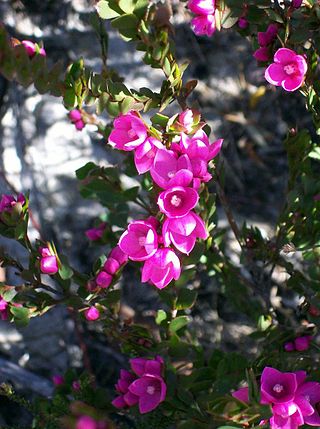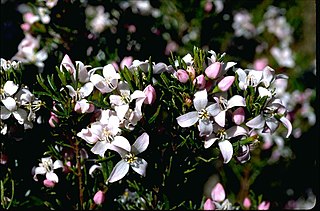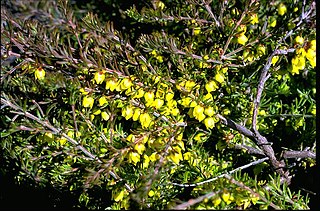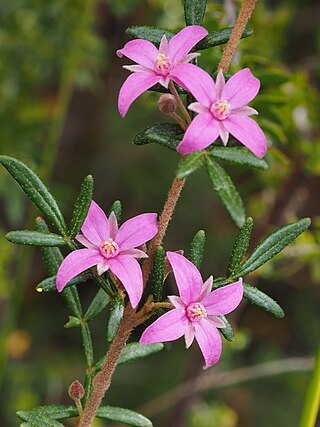
Boronia pinnata is a plant in the citrus family, Rutaceae, and is endemic to New South Wales. It is an erect, woody shrub with pinnate leaves and groups of between three and forty pink flowers arranged in leaf axils. It flowers in spring and early summer and is found in coastal areas between Ballina and Jervis Bay.

Boronia serrulata, commonly known as native rose or rose boronia, is a species of plant in the citrus family, Rutaceae, and is endemic to New South Wales, mainly in the Sydney basin. It is an erect, woody shrub with glabrous branchlets, simple, egg-shaped leaves with fine teeth on the edges, and bright pink, four-petalled flowers on the ends of the branchlets.

Boronia muelleri, commonly known as the forest boronia or pink boronia, is a flowering plant that occurs in forest, woodland and heath in Victoria and New South Wales in Australia. It is an erect, woody shrub or small tree with pinnate leaves and up to fifteen pink to white four-petalled flowers arranged in leaf axils in spring and summer.

Cyanothamnus anemonifolius, commonly known as narrow-leaved boronia or sticky boronia, is a flowering plant that is endemic to south-eastern Australia. It is a shrub with mostly pinnate leaves, with white to pale pink four-petalled flowers in leaf axils.

Boronia citriodora, commonly known as lemon-scented boronia, lemon plant or lemon thyme, is a woody shrub that is endemic to Tasmania. It has pinnate leaves and white to pink flowers that are arranged singly or in groups of up to seven, in the leaf axils or on the ends of the branches.

Cyanothamnus quadrangulus, commonly known as narrow-leaved boronia, is a plant in the citrus family, Rutaceae and is endemic to eastern Australia. It is an erect shrub with four-angled branches, bipinnate leaves and white, sometimes pale pink, four-petalled flowers.

Cyanothamnus baeckeaceus is a plant in the citrus family, Rutaceae and is endemic to eastern Australia. It is a slender or straggling shrub with simple or trifoliate leaves and pink and white four-petalled flowers. It is endemic to the south-west of Western Australia.

Cyanothamnus coerulescens, commonly known as blue boronia, is a plant in the citrus family, Rutaceae and is endemic to southern Australia. It is a small, spindly shrub with glandular stems, small, more or less cylindrical leaves and blue to pinkish mauve, four-petalled flowers. There are two subspecies endemic to Western Australia and a third that also occurs in three eastern states.

Boronia filifolia, commonly known as the slender boronia, is a plant in the citrus family Rutaceae and is endemic to south-eastern Australia. It is a slender shrub with simple or pinnate leaves and pale to deep pink four-petalled flowers.

Boronia glabra, commonly known as sandstone boronia, is a plant in the citrus family Rutaceae and is endemic to eastern Australia. It is an erect or weak shrub with many branches, mostly glabrous leaves with a slightly paler underside, and bright pink, four-petalled flowers arranged singly in leaf axils.

Boronia grandisepala is a plant in the citrus family Rutaceae and is endemic to northern parts of the Northern Territory. It is an erect shrub with elliptic leaves and white, pink or burgundy-coloured, four-petalled flowers.

Boronia granitica, commonly known as granite boronia, is a plant in the citrus family, Rutaceae and is endemic to a small area of eastern Australia. It is an erect shrub with many branches, compound leaves and pink, four-petalled flowers.

Boronia lanceolata is a plant in the citrus family Rutaceae and is endemic to northern parts of the Northern Territory and Queensland. It is an erect shrub with many branches, elliptic to lance-shaped leaves and white or pink, four-petalled flowers. It is the most common boronia in the Northern Territory.

Boronia pilosa, commonly known as the hairy boronia, is a plant in the citrus family Rutaceae and is endemic to south-eastern Australia. It is an erect, woody shrub with hairy branches, pinnate, sometimes hairy leaves and groups of up to ten white to pink, four petalled flowers.

Boronia purdieana is a plant in the citrus family, Rutaceae and is endemic to the south-west of Western Australia. It is a shrub with pinnate leaves and yellow, four-petalled flowers arranged singly in leaf axils.

Boronia warrumbunglensis is a plant in the citrus family Rutaceae and is endemic to a small area in the central west of New South Wales. It is a shrub with many branches, pinnate leaves and one or two pink, four-petalled flowers in the leaf axils. It is only known from the Warrumbungles and nearby districts.

Boronia chartacea is a plant in the citrus family Rutaceae and is endemic to the north coast of New South Wales. It is a shrub with simple, papery leaves and bright pink flowers, usually arranged singly in the leaf axils.

Boronia capitata, commonly known as the cluster boronia, is a plant in the citrus family, Rutaceae and is endemic to the south-west of Western Australia. It is a slender, spreading shrub with simple leaves and pink, four-petalled flowers.

Cyanothamnus inflexus is a plant in the citrus family Rutaceae and is endemic to tablelands near the New South Wales - Queensland border in Australia. It is an erect, woody shrub with pinnate leaves and up to seven white to pink four-petalled flowers in the leaf axils. Boronia bipinnata is similar but has larger, bipinnate or tripinnate leaves and smaller sepals and petals.

Boronia parviflora, commonly known as the swamp boronia, small boronia, tiny boronia, or small-flowered boronia, is a plant in the citrus family Rutaceae and is endemic south-eastern Australia. It is a weak, low shrub with elliptic to egg-shaped leaves with finely toothed edges and up to three pink, white or green four-petalled flowers arranged at or near the ends of the stems.





















